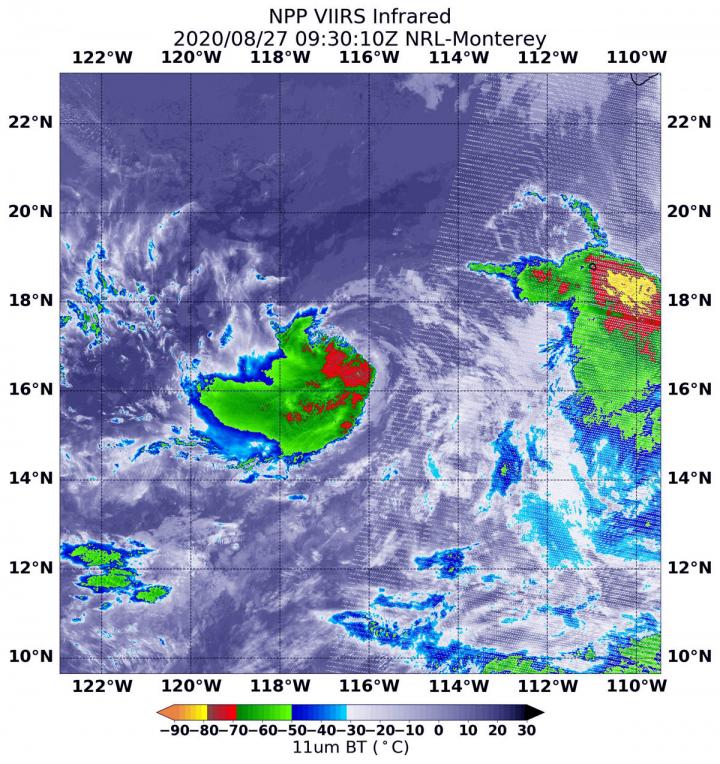
Credit: NASA/NRL
NASA infrared imagery shows that newly formed Tropical Storm Iselle is already battling for its life under wind shear.
Tropical Depression 14E formed in the Eastern Pacific Ocean on Aug. 26 by 11 a.m. EDT (1500 UTC). By 5 p.m. EDT, it strengthened into a tropical storm and was re-named Iselle.
NASA’s Infrared Data Finds Push of Winds
Tropical cyclones are made up of hundreds of thunderstorms, and infrared data can show where the strongest storms are located. That is because infrared data provides temperature information, and the strongest thunderstorms that reach highest into the atmosphere have the coldest cloud top temperatures. Strongest storms with cloud top temperatures as cold as minus 70 degrees Fahrenheit (minus 56.6. degrees Celsius) were west of the center and were dropping large amounts of rain.
On Aug. 27 at 5:30 a.m. EDT (0930 UTC), the Visible Infrared Imaging Radiometer Suite (VIIRS) instrument aboard NASA-NOAA’s Suomi NPP satellite captured a visible image of the structure of Iselle. The storm was elongated and strong storms appeared to be pushed southwest of the center from vertical wind shear.
National Hurricane Center (NHC) Hurricane Specialist Andrew Latto noted in the 11 a.m. EDT discussion, “Iselle consists of a rather ragged looking area of deep convection being sheared to the southwest of a partially exposed low-level center.
Moderate-to-strong easterly to northeasterly vertical wind shear will likely prevent Iselle from strengthening over the next couple of days.
What Wind Shear Does to a Tropical Cyclone
In general, wind shear is a measure of how the speed and direction of winds change with altitude. Tropical cyclones are like rotating cylinders of winds. Each level needs to be stacked on top each other vertically in order for the storm to maintain strength or intensify. Wind shear occurs when winds at different levels of the atmosphere push against the rotating cylinder of winds, weakening the rotation by pushing it apart at different levels.
Iselle’s Status on Aug. 27, 2020
At 11 a.m. EDT (1500 UTC) on Aug. 27, the center of Tropical Storm Iselle was located near latitude 17.0 degrees north and longitude 115.8 degrees west. Iselle is far from land at about 560 miles (900 km) southwest of the southern tip of Baja California, Mexico. Iselle is moving toward the northeast near 5 mph (7 kph), and this motion is expected to continue through Friday. Maximum sustained winds are near 45 mph (75 kph) with higher gusts. The estimated minimum central pressure is 1001 millibars.
Forecast from NHC
Little change in strength is forecast during the next couple of days. Iselle is expected to begin weakening late this weekend.
NASA Researches Earth from Space
For more than five decades, NASA has used the vantage point of space to understand and explore our home planet, improve lives and safeguard our future. NASA brings together technology, science, and unique global Earth observations to provide societal benefits and strengthen our nation. Advancing knowledge of our home planet contributes directly to America’s leadership in space and scientific exploration.
###
For updated forecasts, visit: http://www.
By Rob Gutro
NASA’s Goddard Space Flight Center
Media Contact
Rob Gutro
[email protected]
Original Source
https:/




